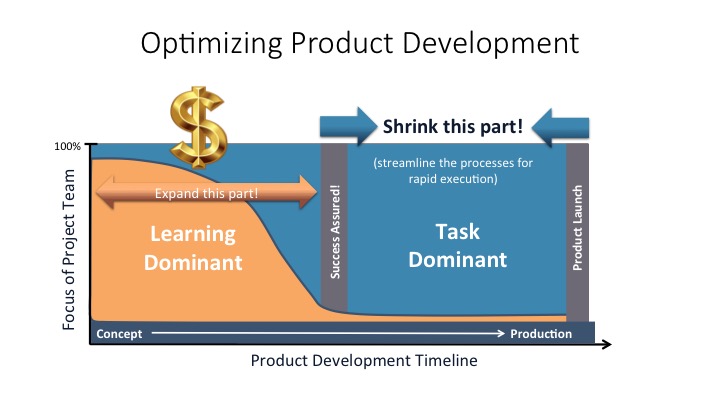Aaron Joseph and Roger Tang, PhD, Principal at HR Tang Consulting
A successful product development process for innovative products is naturally comprised of two mindsets. Early in the product development process, where the uncertainty is the highest, the team’s focus is on rapid learning to close knowledge gaps. These knowledge gaps are those that are fundamental to close, and can include things like:
- Product usage – How will customers want to use the new product and which features are most important to them?
- Product technology – How will a new functional principle, component or algorithm perform in the actual usage environment?
- Manufacturing – Will a supplier be able to produce a new component within tolerances and at a price and volume needed? What will be the yield on a new coating process?
The ideal team for this first part of product development is one that is highly flexible, open-minded, and capable of rapidly changing direction. In contrast, the second part of product development requires a team that is very rigorous, systematic (doesn’t miss a single detail), and efficient.

In the beginning, closing knowledge gaps is the crucial goal for the product development team and therefore everything else is secondary (and actually can be a waste of time and money). Knowledge gaps left unresolved will pop up as serious design or manufacturing problems late in development leading to costly efforts to correct the problems.
Once the team has reached the point of “success assured” where knowledge gaps have been closed, the focus shifts to task dominant activities where resources are brought to bear on systematically completing all the tasks to bring the new product to market. Examples of such activities are:
- Finalizing and releasing mechanical drawings
- Building new manufacturing equipment
- Obtaining product certifications (FCC, UL, etc.)
- Setting up supply chains
- Training manufacturing teams
Often this needs to be accomplished by the same team after switching mindsets, but sometimes it is done by a completely different team altogether. However, the mistake is believing that the same mindset can be applied throughout the product development process. Many startups (especially in Silicon Valley) are excellent at the first part of the process but stumble on the second part. Conversely, large established companies, who have spent many years maturing their processes, are good at the second part of the process but not the first part. Applying task-based project management methods to the first part of the process can give the impression of steady progress (many tasks checked off, milestones completed) while the crucial knowledge gaps (missing learning) remain hidden.

Companies that are good at product development recognize that the “Task Dominant” portion of the process can be continually streamlined, allowing for expansion in innovation. Each time they shrink the task dominant part, they are able to extend the learning dominant part, which increases overall value without increasing the time to market (equivalent time and effort). A good example of this is how Toyota cut production costs and rolled all of those savings back into research and development: (http://www.industryweek.com/companies-executives/toyota-cuts-production-costs-allow-record-research-budget).
Modern software companies use well-established methods (automated builds, automated testing, automated deployment) that have shrunk the second part of development so much that many of their employees may not even be aware it exists. It can therefore be a rude shock if they then try to apply the same (successful) development process to a product which includes hardware.
Does your product development organization encompass both mindsets or is it dominated by one or the other? Are you looking to improve your product development process? Take a look at the references below for detailed information on how companies have adopted knowledge driven product development and doubled or tripled their productivity.
Recommended Reading
Knowledge Driven Product Development – by Ron Marsiglio, Principal Consultant at KnowledgePD – presentation for AME Conference (2012):
http://www.ame.org/sites/default/files/Ron%20Marsiglio.pdf
Accelerating Medical Device Product Development – by Aaron Joseph, Geetha Rao, and Roger Tang – presentation for SME Conference (2015):
Accelerating Medical Device Product Development – SME Conference – MAY2015 from Aaron Joseph

Pingback: Get a Grip on Medical Device Development - Sunstone Pilot, Inc.